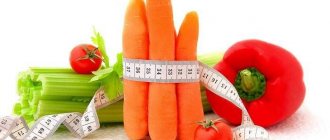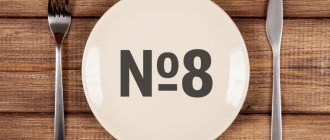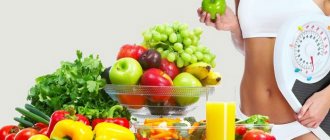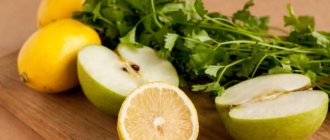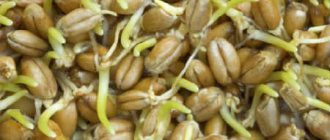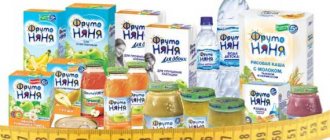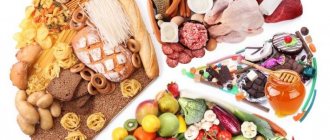Diet Table 4 is used for exacerbations of chronic diseases of the gastrointestinal tract. Indicated for acute gastroenteritis, colitis, and diarrhea. It is aimed at reducing any kind of irritation of the digestive organs. Eating this diet prevents the processes of fermentation and putrefaction in the stomach.
Indications for use
Diet No. 4 is positioned as one of the options for treating various digestive disorders. It is prescribed after the following diagnoses are made:
- Dysentery is an infectious disease accompanied by bloody diarrhea.
- Enterocolitis is inflammation of the large and small intestines.
- Exacerbation of chronic intestinal diseases.
- Colitis is inflammation of the colon.
- Typhoid fever is an intestinal bacterial infection with elements of intoxication (poisoning of the body) and fever.
- Intestinal tuberculosis (the diet is effective only in the first 5-7 days).
Mechanism of therapeutic action
The formation of stool is influenced by the speed of movement of food masses in the intestine, as well as the speed and volume of fluid absorption in the colon. Diet 4 is aimed at combating diarrhea, which is the result of acute inflammatory processes in the small or large intestine. The implementation of the therapeutic effect is the result of several main mechanisms of action:
- Reducing the functional load on the digestive system.
- Providing a gentle regime on the intestinal mucosa due to mechanical grinding of food, the absence of very cold or hot dishes in the diet.
- Reducing the severity of rotting and fermentation processes, as a result of which chemical organic compounds are formed, which have an irritating effect on the intestinal mucosa, causing increased peristalsis and a decrease in the rate of water absorption. The diet involves reducing the amount of carbohydrates and fats, which contribute to the development of rotting and fermentation processes. This leads to an improvement in intestinal microbiocenosis with a decrease in the number of microorganisms representing opportunistic microflora.
- The ratio of the main food ingredients helps to normalize the volume and rate of water absorption, which also affects the normalization of stool.
The implementation of the mechanism of action is possible through rational choice of products, diet, and frequency of meals.
General rules
A diet for intestinal disease involves mechanical, chemical and thermal sparing of the intestines. To do this, it is necessary to completely eliminate foods that stimulate the secretory functions of the stomach and enhance the functioning of the gallbladder. The calorie content of the diet is reduced to 1800-2050 kcal. The preferred heat treatment of products is boiling, stewing, and steaming. General rules of diet No. 4:
- Dishes should be served warm in a liquid, pureed or semi-liquid state.
- You need to eat in small portions. To prevent hunger, food should be taken 4-5 times a day.
- To prevent dehydration, it is important to maintain a drinking regime - drink 1.5-2 liters of water.
- Reduce salt intake to 5-8 grams per day. Sugar is allowed, but in limited quantities.

Comments from nutritionists
Despite the claim that healthy cereals are the basis of a healthy diet, according to nutritionists, only healthy people can practice this diet. The diet is physiologically unbalanced, with a pronounced deficiency in the diet of proteins and fats. Such poor nutrition for 7-10 days with rapid weight loss can lead to the development of metabolic acidosis and negatively affect health, and is also a strong stress for the body. Therefore, it is recommended to introduce a small amount of foods containing protein and vegetable fats into the diet. It is mandatory to take a complex of water- and fat-soluble vitamins and mineral supplements.
Consuming a lot of fiber requires drinking a lot of fluids. constipation may occur .
In general, the imbalance and numerous contraindications for using such a diet are questionable. An alternative to such express mono-diets is a balanced therapeutic diet with a reduced energy value, prescribed for a period of 1-3 months.
Types of diet No. 4
Treatment table No. 4 consists of several subgroups. Each of them is prescribed at a certain stage of intestinal treatment:
- Diet 4A is designed to facilitate intestinal function in the acute period of the disease. This diet helps eliminate pain, diarrhea, flatulence and bloating.
- Diet 4B is prescribed for the treatment of patients with chronic intestinal diseases or pathologies that have progressed to the subacute stage.
- Diet 4B is a transition table - from dietary principles of nutrition to rational ones. It is prescribed to all patients during the recovery stage. Diet 4B allows for the preparation of dishes by baking or lightly frying.
Advantages and disadvantages
| pros | Minuses |
|
|
Authorized Products
When following diet No. 4, you must choose foods that are easy to digest and have astringent properties. The following items should be included in the grocery basket:
- Bakery products - yesterday's wheat bread made from premium flour, crackers, savory cookies.
- Lean meats and poultry - beef, chicken (without skin), rabbit, turkey.
- Dietary fish varieties - hake, bream, cod, carp, perch.
- Eggs – soft-boiled, omelet.
- Dairy products – calcined ground cottage cheese, acidophilus milk.
- Cereals – rice, semolina, oatmeal.
- Any boiled or grated vegetables.
- Fruits, sweets, dessert dishes - applesauce, quince, blackcurrant infusions, jelly, jelly.
- Drinks – tea, coffee, water cocoa, herbal infusions.
Article on the topic: Folk remedies for sore throat in children
Is it really that useful?
In general, a diet based on cereals is very useful for everyone. Naturally, if you strictly follow all the listed rules and accept it with pleasure. Firstly, this diet is an excellent relief for the body. And secondly, cereals contain a large amount of B vitamins, which directly affect the condition of the skin, nails, and hair. Therefore, the diet is reflected not only on the figure, but also on the face.
Its advantages are obvious:
- fast and stable weight loss;
- cleansing the body of waste and toxins;
- improvement of skin condition;
- normalization of intestinal function;
- lowering cholesterol levels;
- regulation of metabolism;
- lack of constant feeling of hunger.
There are practically no contraindications for using diets based on cereals. This, of course, applies to mixed diets. Mono-diets based on cereals are categorically not recommended for pregnant women, those weakened by illness, and those who have problems with the gastrointestinal tract.
Perhaps the only downside is that the porridge quickly becomes boring. It is very difficult for the body, especially accustomed to consuming such “delicacies” as fried potatoes, pickles and smoked foods, to suddenly give up your favorite foods. And at first, even a mixed diet seems meager and monotonous. But believe me, the result is worth trying!
Prohibited Products
You should limit your consumption of fatty foods, sweets, and baked goods. The following are strictly prohibited:
- Bakery products – fresh bread, flour products made from butter dough.
- Fatty meats and poultry - pork, lamb, duck, canned food, sausage, ham, frankfurters, rich broths.
- All fatty fish, seafood marinades, smoked meats.
- Dairy products - cream, sour cream, cheese, whole milk.
- Cereals – millet, pearl barley, pasta, legumes, barley and other crumbly cereals.
- Sauces, marinades.
- Fresh vegetables and fruits, dried fruits, compotes, honey, jam, preserves.
- Liquids - tea, coffee, cocoa with milk, grape juice, carbonated, alcoholic or sweet drinks.
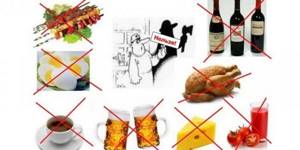
Menu for the week
To avoid unexpected breakdowns, nutritionists recommend thinking through the menu in advance, writing it on a piece of paper and attaching it to the refrigerator. The diet should be based only on permitted products, in compliance with all the rules of diet No. 4. Sample menu for the first week of treatment:
| Breakfast | 2nd breakfast | Dinner | Afternoon snack | Dinner | |
| 1 day | A serving (150 g) of oatmeal with a piece of butter. Any drink. | Soft-boiled egg. | Rice soup (200 ml) with minced chicken meatballs, 1 crouton. | Baked apple. | Chicken soufflé (200 grams), jelly. |
| Day 2 | Rice porridge with water (200 g), 2 biscuits. Drink. | Fruit pudding (100-150 g). | Onion cream soup, a piece (100 grams) of stewed fish. | Kissel, 2 crackers. | Chopped steam cutlets (100 grams), fruit pudding (100 g). |
| Day 3 | Semolina in water (150 grams), 80 grams of cottage cheese. | Homemade berry jelly (100 g). | Buckwheat soup with vegetables (200 ml), 2 croutons, 1 fish cutlet. | Kissel, 4 cookies. | Boiled meat (100 grams), buckwheat (100 grams). |
| 4 day | Protein steam omelette with tea. | Baked apple. | Fish soup with secondary broth (200 ml), 2 croutons. | Biscuits, rosehip infusion. | Rabbit stewed with vegetables (200 g), tea. |
| 5 day | Semolina pudding (120 grams), green tea. | Boiled egg. | Steamed dumplings from minced chicken or turkey (100 g), boiled rice (100 g). | Baked apple. | Liquid buckwheat porridge (100 g), steamed fish (100 g), jelly. |
| Day 6 | Hercules porridge with a piece of butter (100 g), 80 grams of cottage cheese, tea. | Kissel with dried bread. | Soup with meatballs (200 ml), croutons, steamed minced fish balls (100 g). | Rosehip decoction, biscuits. | Cottage cheese pudding, pear broth, 2 crackers. |
| Day 7 | One egg omelette, tea with cookies. | Pear souffle. | Beef broth with boiled vegetables (200 ml), crackers, grated buckwheat with meatballs (150 g). | Green tea, 2 cookies. | Rice porridge with butter (150 g), a piece of steamed fish. |
Doctor's opinion
Diet 4 was developed as part of a set of recommendations for therapeutic nutrition by therapist Pevzner. It is physiologically justified and makes it possible to reduce the load on the organs of the digestive system, as well as normalize stool. Within a few days after starting the diet, the functional state of all organs of the gastrointestinal tract usually improves, stool normalizes, and diarrhea goes away. Since the implementation of dietary recommendations is indicated during an acute inflammatory process in the small or large intestine, they are usually prescribed to the patient in a medical hospital. This allows the attending physician to monitor the diet and diet, and also, if necessary, correct them. As the functional state of the digestive system improves on an individual basis after a doctor’s prescription, it is possible to expand the list of permitted products. The number of meals during the day usually remains the same. By improving the digestion process with the help of diet, it is usually possible to normalize the intestinal microflora, which is disturbed to varying degrees due to inflammatory processes.
For children
In case of intestinal diseases in children who are bottle-fed, formulas containing lactose should be abandoned. Diet number 4 for older children differs from the table for adults only in the calorie content of dishes and serving sizes:
- The energy value of a child’s diet must be reduced to 1500-1700 kcal.
- Before serving the dish, grind through a sieve or grind in a blender.
- All dishes must be kept at a temperature of up to 45 °C. Cold desserts, sweets, and soda are prohibited.
Contraindications
There are several pathological and physiological conditions, the presence of which excludes the use of diet 4:
- Heart pathology of various origins and severity.
- Tendency to constipation, whether of hereditary or acquired origin.
- Renal failure with a pronounced decrease in the functional activity of the kidneys.
- Children's age up to 1 year.
- Hypersensitivity or allergic reactions to most foods that form the basis of diet 4.
The diet for pregnant or breastfeeding women can only be prescribed by the attending physician according to strict appropriate indications. If necessary, it is possible to adjust the type of food products, their volume and regimen of intake.
Diet 4 recipes for every day
Dietary table 4 must be followed from several weeks to months. You can make your diet more varied by learning how to cook healthy meals. Give preference to low-fat soups, viscous porridges, boiled vegetables, baked fruits and berries.
Steamed cutlets in a slow cooker
- Time: 50 minutes.
- Number of servings: 2-3 persons.
- Calorie content of the dish: 156 kcal.
- Purpose: main dish.
- Cuisine: international.
- Difficulty: easy.
The steamed cooking method allows you to preserve all the vitamins, minerals and other beneficial ingredients of the food. To make homemade steamed chicken cutlets, take skinless breast or turkey fillet. For spices, give preference to paprika and turmeric.
Ingredients:
- chicken breast – 300 g;
- breadcrumbs - 2 tbsp. l.;
- egg – 1 pc.;
- onion – 1 pc.
Cooking method:
- Cut the breast and grind it together with the onion in a meat grinder.
- Add egg, spices, breadcrumbs to the minced meat.
- Form patties with wet hands.
- Place the pieces on the steam pan.
- Pour a glass of water into the multicooker and turn on the “Steam” mode.
- Cook the cutlets for 20-25 minutes.

Diet pumpkin soup
- Time: 50 minutes.
- Number of servings: 2-3 persons.
- Calorie content of the dish: 22 kcal.
- Purpose: main dish.
- Cuisine: international.
- Difficulty: easy.
For dietary soup, you can use any vegetables: pumpkin, carrots, onions, potatoes. If desired, you can use secondary chicken or beef broth as the basis of the dish.
Ingredients:
- potatoes – 3 pcs.;
- frozen pumpkin – 150 g;
- carrots – 1 pc.;
- water – 500 ml.
Cooking method:
- Place all the vegetables in a saucepan and cover with water.
- Bring to a boil, reduce heat to low and simmer for 20-30 minutes.
- Add spices to the broth: turmeric, bay leaf, a pinch of grated ginger root.
- Grind the prepared vegetables in a blender.

Nutritional Features
To obtain the necessary therapeutic effect from using Diet 4, it is important to pay attention to several important nutritional features:
- Meals should be taken at least 5 times.
- The main method of preparing dishes is by steaming or boiling. Stewing of some dishes is allowed. Fried and baked foods are excluded.
- It is advisable to take ready-made meals in liquid or semi-liquid form; it is better to grind and chop solid pieces of food.
- Food should be chewed thoroughly before swallowing.
- The last meal is allowed no later than 2 hours (according to the latest data, 3-4 hours is better) before the expected sleep.
In most cases, diet 4 is prescribed in a hospital setting, since medical indications include acute inflammatory processes in the small or large intestine, as well as exacerbation (relapse) of their chronic course. This allows the attending physician to monitor the effectiveness of dietary recommendations and the quality of their implementation. If necessary, a medical specialist can make adjustments to the list of permitted or prohibited foods, as well as the mode of their intake.
